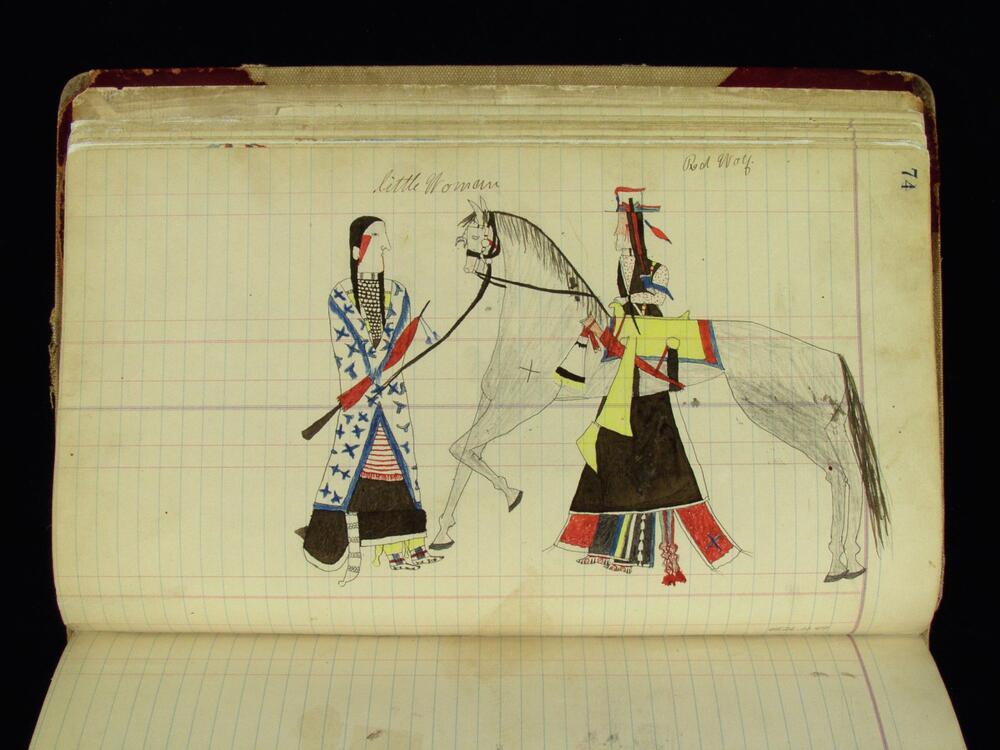The Fan and the Parasol
Scope and Content Notes
This ledger drawing was created by warrior and artist Red Wolf (Arapaho, Cheyenne) in 1887. Although this ink and graphite work follows the Plains figurative painting techniques of the Cheyenne and Arapaho Nations, the art in the Fort Reno ledger book remains distinct as one of the earliest examples of figurative painting using Western media by artists from the two nations. Here, Red Wolf has created an autobiographical narrative scene from memory of a couple engaged in formal courtship, with himself on the right and a young woman wrapped in a Ghost Dance blanket on the left. Their clothing reflects the height of late nineteenth-century Indigenous fashion. Red Wolf’s beaded top hat (adorned with a red feather) and the woman’s red parasol with blue beaded tassels highlight the intersections between Indigenous fashion, trade textiles, and select elements of Western garb. Red Wolf wears a cotton cloth shirt, a black waistcoat, black wool leggings, and a red wool breechcloth. His horse has been decorated with starlike paintwork, and its yellow saddle is lined with red and blue wool. A red knife and sheath ornamented with feathers is affixed to the saddle.
Fort Reno was established in Indian Territory to colonize the region (now Oklahoma) in 1874. Not long after, more than thirty Cheyenne and Arapaho men and one woman defied the military takeover of the land, and they were arrested and sent to Fort Marion (now called Castillo de San Marcos) in St. Augustine, Florida. At Fort Marion, attempts were made to assimilate and colonize the prisoners, who were encouraged to renounce their culture, and were given Western educations and taught to speak and write English. They also continued to make narrative figurative drawings and paintings, although now using media such as graphite, ink, colored pencils, oil pastels, and watercolors on paper rather than pigments and hide. The works are called ledger art because the paper was from accountants’ ledger books. After they were released from prison in 1878, several Fort Marion survivors returned to Fort Reno, where they enlisted as scouts and continued drawing.
—Jordan Poorman Cocker, Henry Luce Foundation Curatorial Scholar for Indigenous Painting Collection Research, 2021
_____________________________
This text was informed in part through consultations with Gilcrease curatorial assistant Jenny Keller, and with Cheyenne and Arapaho Culture Program coordinators Fred Mosqueda and Chester Whiteman Little Woman and Red Wolf meet in a courtship scene.
Little Woman, with her face painted in red, wears an elk tooth dress and carries a folded umbrella. She is wrapped in blanket with blue designs. Finely-dressed Red Wolf wears a flat brimmed hat with a feather in his hair, a vest, calico shirt, and wool leggings and breechcloth. He stands beside his saddled horse.
From the article: Preserving History in the Southern Plains: Cheyenne and Arapaho Ledger Drawings from Fort Reno, Plains Indian Art, Created in Community.
Emma I. Hansen, Curator Emerita and Senior Scholar for the Buffalo Bill Center of the West, 2016.





